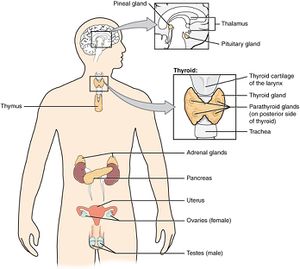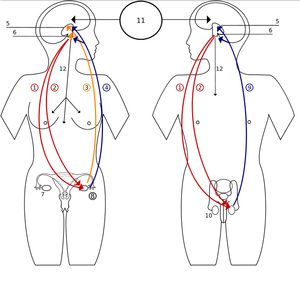Endocrine system

The endocrine system regulate development, growth, energy metabolism, reproduction, and many different behaviors. It uses a combination of glands and hormones to send signals to the nervous system and control functions in the body.[1]
Hormones are the chemicals the endocrine system uses for signalling.[1] Several different glands exist in the body which release hormones. These hormones travel through bodily fluid, usually blood, to the target cells.[1]
Function[edit | edit source]
Three types of hormones may be released: lipid-derived hormones such as steroids, amino-acid hormones (e.g., epinephrine and norepinephrine), and peptide hormones (e.g., insulin and antidiuretic hormone.[2] Steroid hormones permeate tissues and can directly enter the nucleus to trigger DNA to start protein production. Protein hormones do not share this mechanism because they are unable to enter the nucleus due to their membranes being incompatible with the nuclear membrane. Instead, protein hormones attach to messenger receptor cell on the outside of the target tissues' cells. Based on the hormone that attaches, a different cascade of cellular processes will occur ending in tissue response (which could be increased enzymatic activity, cellular secretion, and ion channel opening or closing).[3]
Glands and hormones[edit | edit source]
Pituitary[edit | edit source]
The pituitary gland is a small bulb situated at the base of the brain and both releases hormones and controls other glands which release hormones. It is under direct control of the hypothalamus, a section of the brain right above the pituitary.[4] The hypothalamus receives input about hormonal and homeostatic states in the body, processes that information, then relays instructions to the pituitary gland to respond with certain hormones.[5] For example, osmoreceptors, water-level sensing cells, in the hypothalamus detect when you are dehydrated. The hypothalamus tells the pituitary to release antidiuretic hormone, which notifies the bladder to retain water. Water levels in the body will increase and once at an adequate level the osmoreceptors stop their signaling to have ADH released[6].
| Anterior Lobe Hormones[7][6] | |
|

Pituitary dysfunction can lead to several disorders, including:
- Acromegaly - an overproduction of growth hormone which can cause gigantism in children and oversized limbs in adults.
- Cushing's Disease - usually caused by a tumor on the pituitary, it is an overproduction of ACTH, the hormone that stimulates the production of cortisol. It leads to consistent high levels of cortisol in the bloodstream leading to symptoms such as increased fat around the neck, memory and cognitive dysfunction, and osteoporosis.
- Hypopituitarism - when the pituitary doesn’t produce enough hormones; can cause anemia, decreased appetite, weight changes, joint stiffness, and developmental problems (in children).
Hypothalamus[edit | edit source]
The hypothalamus maintains homeostasis in the body. It receives input from sources such as the vagus nerve (which can relay information about blood pressure and stomach fullness), the optic nerve (which relays levels of light), receptors in the body and skin (which relay temperature), and even has its own receptors which inform about the amount of molecules in the blood[8] (which relays if there is an unbalanced ratio of fluid to molecules).
When the hypothalamus is not functioning properly, many systems become dysregulated. This dysfunction can be caused by a number of different triggers such as an eating disorder, a tumor, brain injury or genetic mutations[9]. A malfunctioning hypothalamus alters motivations to drink, eat and copulate which can lead to malnutrition or overeating, dehydration or overhydration and decreased or increased sexual behavior. Sleep patterns, activity levels, and menstruation may also change[10].
Thyroid[edit | edit source]
The thyroid is a gland located in the throat. It is necessary in proper brain functioning and health, and is important to the development of children and fetus’s brains. The gland also plays a role in controlling the breakdown and use of proteins, carbohydrates and fats[11]. The thyroid has cells that absorb iodine. The cells use iodine to produce T3 and T4, thyroid hormones that can moderate the body’s temperature, and vitals (e.g. blood pressure and heart rate), and the breakdown of various biomolecules such as fat[12].
Dysfunction of this gland can mean an overproduction or underproduction of its hormones. Malfunction can lead symptoms such as to hair loss, muscle fatigue and weakness, sensitivity to environmental temperature changes[13].
Relationship to ME/CFS[edit | edit source]
Hypothalamic-pituitary-adrenal axis (HPA) is the collaborative functioning between the hypothalamus and the pituitary gland. These tissues work together to regulate hormone production and release, and also moderate bodily functions such as temperature regulation, fluid balance, appetite and thirst detection. Hypofunction of the HPA has been identified as a problem experienced in ME/CFS patients. Lower cortisol levels were identified in ME/CFS patients than in healthy controls, and has been shown to be connected to decreased sleep[14]. Exogenous cortisol administration was tested as a possible treatment however these results should be replicated due to the group’s use of solely the Fukuda Assessment of ME/CFS (which may allow for error in diagnosis of the condition). Furthermore, several journals suggested CBT as a feasible treatment option to increase cortisol levels, however due to the extensive literature questioning and undermining the utility of CBT in ME/CFS in overall treatment, other options should be explored in this research.[15][16]
See also[edit | edit source]
Learn more[edit | edit source]
References[edit | edit source]
- ↑ 1.0 1.1 1.2 Clark MA, Douglas M, Choi J (January 30, 2022). "37.5 Endocrine Glands". Biology 2e. Houston, Texas: OpenStax.
- ↑ Clark MA, Douglas M, Choi J (January 30, 2022). "37.1 Types of Hormones". Biology 2e. Houston, Texas: OpenStax.
- ↑ "The Endocrine System" (PDF).
- ↑ "Overview of the Pituitary Gland - Hormonal and Metabolic Disorders". Merck Manuals Consumer Version. Retrieved October 18, 2018.
- ↑ Dougherty, Patrick. "Hypothalamus: Structural Organization". Neuroscience Online: An Electronic Textbook for the Neurosciences. McGovern Medical School - The University of Texas Medical School at Houston. Retrieved October 20, 2020.
- ↑ 6.0 6.1 "The Pituitary Gland and Hypothalamus | Anatomy and Physiology II". courses.lumenlearning.com. Retrieved October 18, 2018.
- ↑ "Pituitary gland | You and Your Hormones". Society for Endocrinology. Retrieved October 18, 2018.
- ↑ Boeree, George. "The Limbic System". webspace.ship.edu. Retrieved October 18, 2018.
- ↑ "Hypothalamic dysfunction | Genetic and Rare Diseases Information Center (GARD) – an NCATS Program". rarediseases.info.nih.gov. Retrieved October 18, 2018.
- ↑ "Hypothalamus / Impact per brain area / Consequences | Braininjury-explanation.com". braininjury-explanation.com. Retrieved October 18, 2018.
- ↑ "Overview of Thyroid Function - Endocrine and Metabolic Disorders - Merck Manuals Professional Edition". Merck Manuals Professional Edition. Retrieved October 18, 2018.
- ↑ "T3 Test: Purpose, Procedure & Risks". Healthline. Retrieved October 18, 2018.
- ↑ "T3 Test: Purpose, Procedure & Risks". Healthline. Retrieved October 18, 2018.
- ↑ Nijhof, Sanne L.; Rutten, Juliette M. T.M.; Uiterwaal, Cuno S. P.M.; Bleijenberg, Gijs; Kimpen, Jan L.L.; Putte, Elise M. van de (April 2014). "The role of hypocortisolism in chronic fatigue syndrome". Psychoneuroendocrinology. 42: 199–206. doi:10.1016/j.psyneuen.2014.01.017. ISSN 1873-3360. PMID 24636516.
- ↑ Twisk, Frank N.M.; Maes, Michael (2009). "A review on cognitive behavorial therapy (CBT) and graded exercise therapy (GET) in myalgic encephalomyelitis (ME) / chronic fatigue syndrome (CFS): CBT/GET is not only ineffective and not evidence-based, but also potentially harmful for many patients with ME/CFS". Neuro Endocrinology Letters. 30 (3): 284–299. ISSN 0172-780X. PMID 19855350.
- ↑ Núñez, Montserrat; Fernández-Solà, Joaquim; Nuñez, Esther; Fernández-Huerta, José-Manuel; Godás-Sieso, Teresa; Gomez-Gil, Esther (January 15, 2011). "Health-related quality of life in patients with chronic fatigue syndrome: group cognitive behavioural therapy and graded exercise versus usual treatment. A randomised controlled trial with 1 year of follow-up". Clinical Rheumatology. 30 (3): 381–389. doi:10.1007/s10067-010-1677-y. ISSN 0770-3198.

